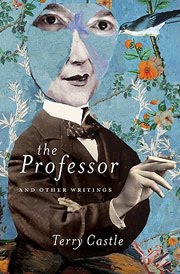The Professor and Other Writings - A Review
 The Professor and Other Writings The Professor and Other Writings is a collection of seven essays by author and professor, Terry Castle. As she wrote in the ‘Author’s Note’ at the front of the book, some of the pieces had been previously published, and in this book, appear in the order in which they were written. Castle added, “Having labored in the dusty groves of academe for over twenty years, I felt---as a new millennium unfolded---a desire to write more directly and personally than had previously been the case.” Intriguing photos serve to introduce, as well as illustrate the theme of each autobiographical essay. Castle unveils her perspectives on love, family, relationships and sexuality, all accompanied by her wicked wit. Nothing has been held back, especially in the title essay, ‘The Professor’, in which she relates her relationship with a female professor. There were times when reading through the book was overwhelming, with the sheer amount of scholarly information that backed personal details. One essay, ‘Courage, Mon Amie’, is a fascinating study of the author’s obsession (or ‘war fixation’, as she puts it) with military history, inspired by her desire to find the gravesite of her great-uncle, who died during WWI. As British-born Castle makes the rounds of France and Belgium, you’re drawn into her search. There are detailed descriptions of the cemetery, trenches, tiny museums, and other military haunts she visits, sometimes alone, other times with a relative. While it may be off-putting to some readers, the author’s passion for war and its trappings is phenomenal, especially as she struggles (as many of us did back in 2002) with myriad emotions in the aftermath of the 9/11 attacks. Another essay, ‘Home Alone’, deals with America’s captivation with design (or shelter) magazines, and the desire to create a space, some sort of secured home of one’s own. Castle admits her own ‘shelter-lit addiction’, relishing in flea market finds and eagerness to get her hands on the latest mag candy. She asserts that it “is all about consumption, luxury goods, and the pipe dreams of upward mobility” that drives one to seek this decorative nirvana. Enhancing her dead-on commentary are quotes from American interior design experts Elsie de Wolfe and Mario Praz, and those from the publishing staff of some of the magazines mentioned in this piece. This essay was a much easier read than the one above. In conclusion, if essay collections laced with scholarly insights and biting humor are your cup of tea, then you’ll want to give The Professor and Other Writings a look. Labels: book review, essay, essay writing, Terry Castle, The Professor and Other Writings
The Immortal Life of Henrietta Lacks Book Review
 I'd never heard of Henrietta Lacks, pictured on the book cover, before I picked up Rebecca Skloot's wonderful book. Chances are, you haven't either. But you may have heard of HeLa cells or at the very least, information about medical research to find a polio vaccine or cure for cancer. In The Immortal Life of Henrietta Lacks, you finally meet the women behind HeLa cells, “the first immortal cells ever grown in a laboratory,” as well as her family and key medical researchers. The author first learned of HeLa when she was 16, and she soon grew fascinated by the story of Henrietta, an African-American woman, and her cells from a cervical cancer tumor. These cells have not only helped develop the polio vaccine and made important discoveries in fighting cancer, they've also led to advancements in gene mapping and in vitro fertilization. I'd never heard of Henrietta Lacks, pictured on the book cover, before I picked up Rebecca Skloot's wonderful book. Chances are, you haven't either. But you may have heard of HeLa cells or at the very least, information about medical research to find a polio vaccine or cure for cancer. In The Immortal Life of Henrietta Lacks, you finally meet the women behind HeLa cells, “the first immortal cells ever grown in a laboratory,” as well as her family and key medical researchers. The author first learned of HeLa when she was 16, and she soon grew fascinated by the story of Henrietta, an African-American woman, and her cells from a cervical cancer tumor. These cells have not only helped develop the polio vaccine and made important discoveries in fighting cancer, they've also led to advancements in gene mapping and in vitro fertilization.
What fascinated Skloot even more than HeLa cells and their contribution to scientific research is the story of Henrietta and her family. She was a poor Southern tobacco farmer who went to Johns Hopkins Hospital in Baltimore, Maryland in the 1950s with cervical cancer. Doctors took a sample of her tumor without her knowledge or her family’s consent before she died.
The HeLa cells are still alive today and have multiplied into weighing more than 50 million metric tons—“as much as the Empire State Building.” Her family knew nothing about her cells being alive and helping modern medicine until the 1970s when doctors called her husband and children for research without informed consent.
 By the time Skloot met Henrietta’s family members in the late 1990s and started interviewing them for her book, many of them, including her grown children, trusted no one, especially Caucasian reporters who wanted to know about Henrietta’s cancer cells. But because Skloot cared so much about Henrietta's story and knew it like her own, Henrietta's relatives started to trust her and share important information with her. By the time Skloot met Henrietta’s family members in the late 1990s and started interviewing them for her book, many of them, including her grown children, trusted no one, especially Caucasian reporters who wanted to know about Henrietta’s cancer cells. But because Skloot cared so much about Henrietta's story and knew it like her own, Henrietta's relatives started to trust her and share important information with her.
Besides introducing readers to Henrietta Lacks, her husband, and her children, Skloot skillfully informs readers about cell research and medical discoveries. Skloot also writes about the ethical issues, court cases, and laws surrounding these cells and other cell lines from patients, who didn’t realize that doctors were using them for research and making money from them. She takes a complex issue and writes about it so anyone can understand the science, medicine, and law. But more importantly, she intersperses the often heartbreaking personal story of Henrietta among the scientific fact.
The most captivating chapters of this book are the real stories of the Lacks family’s struggles. For example, Skloot befriends Henrietta’s daughter Deborah, who was preschool age when her mother died. Deborah was on a quest for almost 30 years to find out what happened to her mother. All Deborah wanted was for her mother to get the recognition she deserved.
In one especially touching scene, Skloot writes about Henrietta Lacks Day on October 11, 1996 in Atlanta during a conference at the Morehouse School of Medicine. Dr. Roland Pattillo organized the first ever HeLa Cancer Control Symposium; and Deborah , her father, and her siblings attended.
Deborah spoke to the conference attendees and said, “When Dr. Pattillo called me, it all became real. For years, it seem to be a dream. . .Can this about our mother be true?. . .No one from the medical field took the time.”
If you are interested in biology and medical research, you won’t want to miss this book. But even more, if you are interested in human stories and how we are all connected to one another, then read this book and share it with others.
Review by Margo L. Dill, https://margodill.com/blog/, Follow me on Twitter: https://www.twitter.com/Margo_L_Dill Rebecca Skloot photo credit: Manda TownsendLabels: book review, Margo L. Dill, Random House, Rebecca Skloot, The Immortal Life of Henrietta Lacks
Books and Water: Combining our greatest resources
 When The Muffin sought reviewers to write about "Water: The Epic Struggle for Wealth, Power, and Civilization" by Steven Solomon (Harper/HarperCollins Publishers; $27.99; ISBN 9780060548308) I jumped at the chance. Why would I want to dive into more than 500 pages about water? Sure, I appreciate a good non-fiction read. But wouldn't a book on water be, well, ahem, a little dry? Admittedly, "Water" may not always be the most riveting read, in places trickling a little slowly. However, Solomon understands the global and historical importance of water--how our planet with 70 percent water sets us apart from our solar system neighbors. He takes such a regular and taken-for-granted resource and, in a well-researched and well-written book, brings his readers along for an epic ride. Solomon, a respected journalist, has succeeded in tackling a serious book about an amazing substance that affects all of us, no matter how much of your daily intact you actually drink or where you live. And water has impacted societies from the earliest times--and continues to do so. Divided into four parts, Solomon takes his readers from the ancient times, explaining the importance of water and irrigation for early civilization. He incorporates the importance of water in early trade and the age of discovery. Water plays a role in the industrial society, giving way to the rise of our international focus. The fourth section, with the lens developed throughout the previous sections, brings readers into the "The Age of Scarcity." Solomon also addresses the politics of water in the twenty-first century. One of my favorite parts of the book is Solomon's consideration of the importance of sanitation and clean water. England in 1858 was not the cleanest place to live and 25,000 Londoners had died from two cholera epidemics in the previous 10 years. Clean water was at a premium and, that summer, the heat and stench increased, giving rise to "The Great Stink." The stench succeeded where years of politicking had failed forcing Parliament to pass legislation (in 18 days) to "construct a proper sanitary sewerage system befitting the world's leading city." Solomon writes: "Throughout history, water's life-giving indispensability had always been double-edged. On the one side, drinking two to three quarts of clean freshwater daily sustained each person's existence.... Yet simultaneously, drinking contaminated water and exposure to stagnant water bearing an infiltrating army of diseases also was the main source of human illness, abbreviated life spans, and physical miseries." Those words may seem obvious to some, it is that accessibility coupled with the historical intricacies that makes this book so fascinating to read. While the book may not be for everyone, I can see this book flying off shelves and becoming required reading in academic settings (perhaps an environmental studies course or two). If you desire a captivating and accessible work about something we often take for granted, you should add this one to the top of your reading list. Elizabeth King Humphrey is a writer and creativity coach. When she is not drinking the recommended daily allowance of water, she contributes to AOL's ParentDish, she blogs at The Write Elizabeth, delving into creativity in everyday places.Labels: book review, drinking water, Elizabeth King Humphrey, Steven Solomon
A Review of 'A Change in Altitude' by Anita Shreve
By Jill EarlNewlyweds Margaret and Patrick arrive in Kenya intending to stay for a year for his residency at a local hospital. As they adjust to new surroundings, so very different from their American upper-class life, Patrick easily settles into his medical duties. Life for Margaret, however, increasingly catches her off balance. Then, a tragic accident occurs and in its aftermath, Margaret's journey for closure involves an attempt to rescue her young marriage while rediscovering herself in the process. I enjoyed A Change in Altitude, Anita Shreve’s latest release, which was my first encounter with the author’s novels. I initially found the characters a bit off-putting, particularly their hosts somewhat pompous Arthur and his icy wife Diana, but warmed up to central character Margaret quite a bit as I continued to read. I attributed my change of heart to the character’s willingness to do more than just ‘do time’ for a year on the African continent. While husband Patrick slips into routine at the hospital, Margaret begins to tentatively explore her new homeland, taking on a position as a photographer for a newspaper, as she struggles---along with fellow Kenyans---with understanding and dealing with major political changes in the country at the time. Ms. Shreve's vivid descriptions of Margaret's world were sensory experiences that added depth to the story. I marvelled the breaktaking vista of Mt. Kenya, felt the dust of the savannah settle into the characters' clothes as they trekked through it, and was refreshed by cooling rains. When Margaret's visits to a local shanty town become more frequent, we both grow to appreciate the strength and beauty of its residents seemingly hidden in ramshacked, tin-covered shacks. It’s been said that Ms. Shreve has a talent in revealing the intimate details of human relationships, and I’m inclined to agree. With events leading up to and beyond the accident, Margaret is forced to confront deeply hidden truths about herself, causing her to question everything and everyone she knows, including her marriage to Patrick. Travelling with Margaret on her journey was both painful and enlightening. There weren’t any easy answers to her questions or mine as I read, but then again, life doesn’t offer them either. If you like your novels to challenge your perspective of relationships, I think it’s worth giving A Change in Altitude a look. And for more on the acclaimed author, please check out our interview with Ms. Shreve in the December 2009 newsletter. Labels: A Change in Altitude, Anita Shreve, book review, Jill Earl
Ready to be Red Hot?
Sometimes I feel like some of my questions about book marketing are too stupid to ask. Is Twitter a toy or a marketing tool? What exactly does 2.0 mean? How do I transform my in-person writing class into a telephone seminar? Finally, someone has peeked inside my head gathered all my stupid questions and answered them in a book! I enjoyed Penny C. Sansevieri’s Red Hot Internet Publicity from the moment I opened it. The table of contents for this 279 page book is five pages long—each chapter is divided into multiple subsections making it easy to find the exact information you want. No more paging through chapters wondering what happened to that nugget of info you want to reread. And the information! Everything from avatars to autoresponders to ATL. Sansevieri manages to cover everything from the basics to complex marketing ideas without boring her reader or making them feel stupid. And because the book is divided into varying short sections: lists, quizzes, paragraphs, interviews, personal anecdotes you just seem to speed through it. Not only do you get 200+ pages of information but the book is also peppered with web addresses for real-live examples of the subjects she’s talking about. Because isn’t the first rule of writing to show, not tell? She also isn’t selfish about giving lists of books, websites, blogs and online communties she thinks would help her readers. This book isn’t just for passive reading—you’ll be writing notes in the margins, highlighting, making lists. So often I read books once and then pass them on to friends but not Red Hot Internet Publicity. It’s earned a spot on my permanent shelf right next to Strunk and White. I feel it can be useful to all types of writers: bloggers, wanna-be authors, and even those with several books under their belt. Sansevieri didn’t just answer my questions, she told me things I didn’t even realize I needed to know. It’s a book you’ll refer to again and again. I want all my friends to read it. But they need to get their own copy—I’m keeping mine! Bio: Penny C. Sansevieri is the CEO and founder of Author Marketing Experts, Inc. and The Virtual Author Tour ( www.amarketingexpert.com ). She is an expert on book marketing and was featured in 20 Questions column in the August issue of WOW ! Women on Writing. Labels: book review, marketing, publicity
 By Tricia Ares Well, now that the chaos we call the holidays is finally over. It’s time to draw a hot bath, grab a cup of tea (or your favorite martini) and relax with a good book. If you enjoy a novel as steamy as that bathroom mirror, here’s one I suggest: Patricia Waddell’s futuristic romance True Deception will satisfy any craving for passionate adventure. Waddell weaves the destinies of a self-reliant heroine and a handsome, mystery man into a tension packed romance. Her lush descriptions will draw you into an alien world that is both exotic, yet familiar: “Kala stood on the balcony, her hands on the railing, looking at the lake. It was past seven o’clock; the sun was dipping below the horizon, its orange rays shooting up, creating blocks of shadows over the earth—moving shadows that floated across the water like ghostly birds.” Kala Char’ari is a resistance fighter, and a survivor, determined to save her people from the political and economic exploitation of the Conglomerate. But when the desperate band is dealt a deadly blow, a skeptical Kala must accept the help of a seductive stranger, Aedon Rawn. Aedon Rawn is a man with his own agenda, revenge, and he’ll do whatever it takes to achieve it. After his wife and daughter are murdered by Conglomerate pirates, Aedon becomes an emotional void. Infiltrating Kala’s resistance will bring him one step closer to his goal, but there is one complication: “Kala exuded vitality. She wasn’t afraid of life, taking the consequences along with the rewards, never looking back, always thinking of the future. She exited him in a way no other woman ever had.” As their attraction becomes palpable it puts their mission at risk. True Deception will have women fantasizing about Aedon’s chameleon eyes, treasuring each moment with the intelligent, yet sensitive, hero. Women will also admire the flawed strength of a woman who must step out of the shadows, challenging the powerful men who may not accept her leadership. Patricia Waddell is certainly a master of her craft, balancing action, intrigue, and sex appeal to create a fast paced novel that will draw you through each titillating turn. ---------- Find out more about Tricia Ares by visiting her website: www.triciaares.comOr the blog she edits: www.modernmatriarch.wordpress.comLabels: book review, Patricia Waddell, Tricia Ares, True Deception
|
 The Professor and Other Writings is a collection of seven essays by author and professor, Terry Castle. As she wrote in the ‘Author’s Note’ at the front of the book, some of the pieces had been previously published, and in this book, appear in the order in which they were written. Castle added, “Having labored in the dusty groves of academe for over twenty years, I felt---as a new millennium unfolded---a desire to write more directly and personally than had previously been the case.”
The Professor and Other Writings is a collection of seven essays by author and professor, Terry Castle. As she wrote in the ‘Author’s Note’ at the front of the book, some of the pieces had been previously published, and in this book, appear in the order in which they were written. Castle added, “Having labored in the dusty groves of academe for over twenty years, I felt---as a new millennium unfolded---a desire to write more directly and personally than had previously been the case.”













